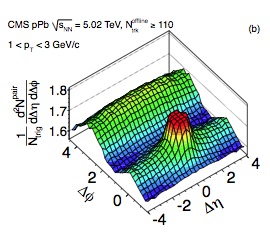Cosmic questions

Angles correlate between particle pairs emanating from quark-gluon plasma, the product of collisions between protons and lead nuclei in the Large Hadron Collider (LHC). The red peak (with its top chopped off for this use) represents particles shot out by jets. In both the side view of the collision chamber (Δη) and the LHC down-the-barrel view (Δφ), the angle between any pair of particles measures zero or near zero. The ridge near the back represents particles departing in opposite directions, from jets that are joined back to back. Viewed down the collider’s barrel, the angle between the particles in each pair is about 180 degrees. The lower ridge extending to the sides of the truncated red peak shows the new correlation. The down-the-barrel angle between the members of each pair is about zero. (From the CMS Collaboration’s paper, “Observation of long-range, near-side angular correlations in pPb collisions at the LHC.”)
A few of the correlations they found offered no surprises. The first of them emerged at angles at or near zero degrees. This often-seen correlation arises when jets form, tossing out particles one after another like baseballs from a pitching machine. The angles between these paths are naturally close to zero degrees.
The second correlation shows up at 180 degrees. This correlation also is familiar because some particles shoot out in exactly opposite directions from jets that are locked together back to back.
Other correlations result from directional flows of particles that form as the fireball expands. Velicanu and Li used statistical methods to correct for these errant correlations.
The still-unexplained correlation was left standing. Viewed from the side of the collider, the two particles in each of these pairs appear to shoot in all directions, with the angle between any pair ranging from about 120 degrees to 240 degrees. But viewed looking down the collider’s barrel, the particles leave as pairs following almost exactly the same path – that is, the angle between the two paths is close to zero degrees.
This final correlation is not altogether new. It cropped up in data from Brookhaven National Laboratory’s Relativistic Heavy Ion Collider when gold nuclei were pitted against each other, and again at the LHC in lead-on-lead collisions. Random event generators predicted these correlations based on the almond-shaped fireballs such collisions produce. The asymmetrical expansion expected from such fireballs leads to the unusual correlation.
The correlation took on an air of mystery when it showed up in the data from proton-proton collisions, which do not form asymmetrical fireballs and, in fact, may not form QGP at all. The short run of proton-lead collisions in September yielded the strongest such correlation so far.
Scientists have been speculating about what might cause this correlation. Are newly formed particles exhibiting quantum entanglement, in which both bear a memory of their common-parent proton? Or is the correlation a sign of a never-before-seen type of matter?
The September experiment was a prologue to a longer run in January of this year, which generated billions of useful collisions. Velicanu and Li are analyzing the results. “The reason this is interesting is that we can finally put ‘the feet to the fire’ of some of the popular theories that arose to explain this data,” Velicanu says. In particular, the color glass condensate theory holds that the correlation denotes a novel state of matter and predicts data for collisions that give off three or four times more particles than the meager average of 110 per collision seen in September. “The new data can tell us how well this theory survives the data.”
About the Author
Andy Boyles is a senior science writer at the Krell Institute and contributing science editor at Highlights for Children Inc.




